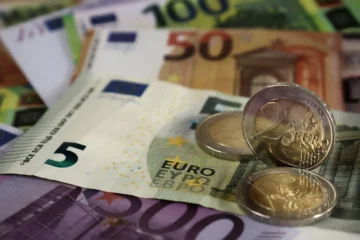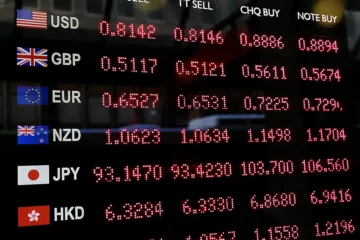US
The Dow Jones Industrial Average closed at 26,816.59 on Friday recording a weekly gain of 0.91%. The S&P 500 closed at 2,970.27 up 0.61% w-o-w. Both these figures are the result of a particularly bullish market on Friday with gains equal to 1.42% and 1.32% respectively.
Indeed, the Federal Reserve announced on Friday that it would begin buying $60 billion of Treasury Bills per month to ensure liquidity in the banking system. Moreover, on Wednesday, the Fed released minutes from its September 17th – 18th meeting and officials have not dispelled market expectations that they would cut interest rates at their meeting later this month, for their third reduction this year.
The yields on 10-year and 2-year Treasuries staged their biggest three-day gains through Friday, with the 2-year yield climbing to 1.59% and the 10-year yield rising to 1.73%.
In September, the U.S. consumer-price index was unchanged at 1.7%, slightly below market consensus of 1.8%, since pick up in food inflation was offset by a decline in energy prices. On Friday, it was disclosed the University of Michigan’s Consumer Sentiment Index, that rose to 96 this month from 93.2 in September, against market expectations.
For the upcoming week, we will be looking at retail sales and business inventories on Wednesday, housing and industrial production on Thursday.
Europe
For the first time since weeks, the German 30-year yield rose into positive territory at 0.1%, due to an increasing number of stimulus opponents within the ECB governing council and among the technical advisors. Yields on the 10-year Bund rose to -0.44%, while the Italian 10y BTP arrived at 0.94%.
This week Germany published its September YoY growth rate in CPI, standing at 1.2%, matching the August reading. Next week the ECB will publish its Industrial Production data, while Germany and the EU will publish the ZEW Economic Sentiment Index.
The EU has approved the Greek government scheme designed to clean up its banks from toxic debt. Under the scheme, the government will be able to guarantee a part of these NPLs, which represent roughly 40% of aggregate overall loans.
The Europe Stoxx 50 index rose by 3.57% to 3,569.92, as markets expect to resume trade talks and improved Brexit outlook. Indeed, Donald Tusk, the head of the European Council, said that he is feeling slightly more confident about the chances that the EU and UK will reach a deal on Brexit. Among the major indexes, the DAX rose by 4.15% to 12,511.65, while the CAC40 ended at 5,665.48 and the FTSE MIB at 22,165.34, rising respectively by 3.23% and by 3.24%.
As far as single-stock stories are concerned, SAP stock rose by almost 10%, as the CEO stepped down after nine years of tenure. UniCredit said that is planning to charge negative interest rates on its deposits, joining other European banks.
UK
News on Brexit developments keeps driving UK financial markets. On Thursday, Boris Johnson and the Irish Prime Minister Leo Varadkar reported optimism for a possible deal and the European Commission said that intensive negotiations will soon take place between the EU and UK. Markets players have moved to price the increasing likelihood of a last-minute deal on Brexit, as a revised deal could be agreed as early as the next European Council Summit” on October 17-18. Moreover, positive news on UK economy was released on Thursday by the Office for National Statistics, indicating a 0.3% GDP growth in the three months to August, driven by the service sector despite a weak performance of manufacturing. Market players are now expecting the UK to grow in Q3, reversing the 0.2% contraction recorded in Q2, thus avoiding a technical recession.
Positive news translated into a risk-on sentiment toward UK assets. Over the week, the pound jumped at the highest levels under Boris Johnson’s premiership, appreciating 1.92% against the Euro and 2.73% against the dollar, with the GBPEUR at 1.1450 and the GBPUSD at 1.2668 on Friday. Moreover, for the first time since the Brexit referendum, the one-month risk reversal turned positive. A negative risk reversal indicates that investors are increasingly demanding protection against a weaker pound, making puts more expensive than calls.
The FTSE 100 closed on Friday at 7,247.08, up 1.28% from last week levels. The safe UK govies sold off amid the optimism on Brexit talks and the positive UK economic news. The 10-year Gilt yield closed on Friday at 0.71%, last Friday it traded at 0.44%.
Next week will be characterized by multiple economic data releases for the UK economy: August unemployment rate on Tuesday (consensus 3.8%, previous reading 3.8%) and September inflation data on Wednesday.
Rest of the World
The Shanghai SE Composite closed at 2,973.66 on Friday, after Chinese markets have reopened on October 8th, recording a gain of 2.3%. The Caixin China General Composite PMI rose to 51.9 on September 2019, the highest in five months, from 51.6 in the previous month. On Friday, following the meeting of President Trump and Chinese Vice Premier Liu Hu, the U.S. and China took an initial step to cement a trade agreement that had been derailed, with Washington saying it would shelve a planned increase in tariffs from 25% to 30% on $250 billion goods imported from China, while Beijing would increase purchases of U.S. agricultural products, amounting to $40-$50 billion.
In Japan, the Nikkei 225 fell 2.1% for the week and similar declines were posted by the large-cap Topix index. These results were driven by the negative report on the Japanese business conditions in August, pointing at a worsening economy, slipping toward a recession. Clearly, trade tensions have weighed on the performance of the Japanese economy, which is the fourth-largest global exporter. The Japanese yen weakened modestly during the week, closing on Friday at USDJPY 108. Insurance has been the worst-performing sector in the Japanese stock market this week, dropping 2.72% on the concern of high losses incurred as a result of the typhoon Hagibis.
In Brazil, the Bovespa Index recorded a weekly gain of 1.2%, boosted by the market expectation that the central bank will continue to cut interest rates (currently the key policy rate is at 5.50%, an all-time low) in the attempt to fight deflationary pressures. In September, Brazilian CPI was -0.04%.
Brent Crude closed on Friday at $60.51 a barrel, increasing 3.7% from a week ago. WTI Crude closed at $54.70. A sharp rise happened on Friday due to reports of a possible missile attack on the Iranian oil tanker Sabiti, 60 miles off the Saudi Arabian port of Jeddah.
Next week, underwriters are expected to deliver a recommended valuation for the IPO of Saudi Aramco close to $1.5 trillion, below the $2 trillion targeted by Crown Prince Mohammed bin Salman.



0 Comments